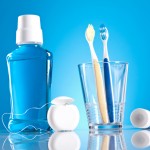
Caries and periodontal disease are very common, and an effective oral hygiene regimen is an important element in their prevention. Regular disruption of the microbial biofilms (dental plaque) that build up on teeth by toothbrushing is a key part of this, but many have difficulty in maintaining effective plaque control. Antimicrobial mouthwashes have been developed to help control plaque and while chlorhexidine has been shown to be effective it has a number of adverse effects so a broad range of herbal mouthrinses has appeared in recent years.
The aim of this review was to assess the effect of herbal mouthrinses as an adjuvant to oral hygiene measures in reducing dental plaque formation and gingival inflammation in adults with gingivitis.
Methods
Searches were conducted in the PubMed/Medline, Embase, Cochrane—Central Register of Controlled Trials (CENTRAL), Latin American and Caribbean Centre on Health Sciences (LILACS/BIREME), Web of Science, Clinical Trials Registry, PROSPERO, The National Dental Trial Registry, US Clinical Trials Registry and OpenGrey databases, and CAPES thesis bank and reference lists of the selected studies. Randomised controlled trials (RCT) of at least 2-weeks duration were considered.
Two reviewers independently screened and selected studies extracted data and assessed risk of bias on 7 domains (allocation concealment, blinding of participants and personnel, blinding of outcome assessment, differential losses and exclusions, intention to treat, selective reporting and statistical power (sample size calculation or post hoc statistical power). A narrative summary of the findings was presented because of study heterogeneity.
Results
- 20 RCTs (19 parallel, 1 cross-over) were included with follow up periods ranging from 14 days to 6 months.
- The herbal produces included 17 different plants [Triphala®, Hiora®,Terminalia chebula, Camellia sinensis (green tea) Ocimum gratissimum, sanguinarine (Veadent®)Melaleuca alternifolia, Cinnamomum zeylanicum, Calendula flower, Anacardium occidentale, Verbena officinalis, Zingiber officinale and Rosmarinus officinalis , Cymbopogan citrates (lemon grass), Matricaria chamomilla and Schinus terebinthifolius and Curcuma long].
- A majority used a twice daily frequency using 10-15mls and rinse times between 30-90seconds.
- None of the included studies were at low risk of bias. Six were at high risk of bias the rest at unclear risk.
- All 20 studies found significant differences in favour of the herbal products when compared to placebos in both outcome, plaque index and gingival inflammation
- 5 studies demonstrated higher percentage plaque reductions than chlorhexidine with studies demonstrating finding higher percentage reductions in gingival inflammation with herbal products over chlorhexidine
- Only 5 of the included studies reported on adverse effects with 3 reporting no effects.
Conclusions
The authors concluded: –
The present systematic demonstrated that most herbal products used as an adjuvant to oral hygiene achieved better results in comparison with a placebo mouthrinse. Products as Camelia sinensis, Azadirachta indica, Anacardium occidentale Linn, Schinustere binthifolius and Curcuma longa have presented better results in plaque reduction and gingivitis in relation to CHX. However, the unclear risk of bias of most included RCTs precludes definitive conclusions.
Comments
Previously we have looked at systematic reviews of chlorhexidine (Dental Elf – 17th Apr 2017) aloe vera (Dental Elf – 12th Apr 2019) and Salvadora persica (Dental Elf – 3rd May 2019). The 2017 Cochrane review found high quality evidence to support the use of chlorhexidine for the reduction of plaque and gingivitis. However, its extrinsic staining and taste disturbances are well known adverse effects with longer term use. Reviews also suggested benefits with adjunctive use of Aloe Vera and Salvadora persica but the quality of supporting evidence was low.
This new review looks at a broad range of herbal mouthwashes while all of the agents tested demonstrated positive effects compared with placebo their performance against chlorhexidine was more mixed. However, it should be noted that none of the included studies was at low risk of bias with 6 being at high risk. Five of the included studies had follow-up periods of less than 3 months which was a minimum inclusion criterion for the Cochrane review of chlorhexidine mouthwash and many of the trials had small group sizes. Because of the wide variety of products tested and the heterogeneity of study designs no meta-analysis could be conducted. While the findings suggested that most of the products tested had a positive effects high quality well conducted and reported studies are needed to properly assess the effectiveness and any potential adverse effects of these adjunctive agents.
Links
Primary Paper
Santi SS, Casarin M, Grellmann AP, Chambrone L, Zanatta FB. Effect of herbal mouthrinses on dental plaque formation and gingival inflammation: A systematic review [published online ahead of print, 2019 Dec 14]. Oral Dis. 2019;10.1111/odi.13254. doi:10.1111/odi.13254
Other references
Dental Elf – 3rd May 2019
Salvadora persica (Miswak) mouthrinse is it as effective as chlorhexidine mouthwash?
Dental Elf – 12th Apr 2019
Aloe vera mouthwash: how does it compare with chlorhexidine?
Dental Elf – 17th Apr 2017
Dental Elf – 5th Oct 2016
Essential oils mouthwash reduced plaque and gingival inflammation
